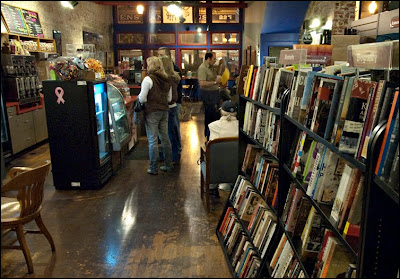 Viddler On The Roof with The Scariest Dream Ever
Viddler On The Roof with The Scariest Dream EverEast Aurora, NY
Photo copyright by Dory Adams
(click on image to enlarge)
In late September when we were in East Aurora, NY on vacation, the shop windows in the historic village displayed original paintings and text from The Scariest Dream Ever, a children’s book written by Maria T. DiVencenzo and illustrated by Alixandra Martin. We’d arrived in town after the festivities surrounding the Storybook Window Walk, an event to promote the release of the book, but were nonetheless charmed by seeing the shop windows on a quiet Monday morning before the village stores opened for business. A stroll down the street looking at shop windows was like a walk through the pages of the book.
It was amazing to see how the community supported the publication of this book by a local writer and artist so wholeheartedly. At the center of Main Street atop Viddler’s Five and Ten Cent Store, the figure known as “Viddler on the Roof” held a copy of The Scariest Dream Ever high in the air. Viddler’s was one of forty-eight businesses involved in the event. I contacted author Maria T. DiVencenzo who said, “I have worked in the publishing industry for twenty years, and have never before been part of such a unique, creative, charming, and plain old fun event. The support of the community was astounding. The delight of the visitors was unforgettable. Truly a remarkable, spectacular day.”
Artist Alixandra Martin of RedFISH Art Studios and Gallery in East Aurora created the whimsical illustrations for the picture book, and it was these original paintings which were on exhibit in the storefront windows. When I asked DiVencenzo if the displays were still up for Halloween, she responded that they were taken down after about a week, and she made the good point that even though there is a witch in the scary dreams, it is not technically a Halloween book since children have scary dreams all year round. I consider myself lucky to have seen the storybook windows in a serendipitous way as my husband and I strolled down Main Street on our way to get a coffee-to-go at the local coffee shop as we were leaving town.
The book’s message is about the power of imagination. The message of East Aurora’s Storybook Window Walk is about how a community of businesses and merchants came out full force to support and celebrate a project by local artists with pride to help launch the book. DiVencenzo said, “My hope is that events like the Storybook Window Walk, and programs like the Storybook Support Program and HeroConnect (which we just launched last week) will help readers discover our books. With all the talk about the end of ‘books’ . . . I keep trying to remind people that there will always be a place for great stories. Picture books, in particular, must be viewed and appreciated not only as a delightful tool that inspires a love for reading while teaching a child basic skills in reading and understanding context, but as a child’s first exposure to FINE ART. In a world inundated with machines, technology and touch screens, picture books are a hands-on opportunity for our children to view and touch fine art, while being delighted and inspired by it.”
I emphatically a
 gree. The details of illustrations in the children’s books from my own childhood are deeply embedded in my visual memory, as are tactile memories of the way those books felt in my hands as I turned the pages – long before I could make sense of the words on the page, long before I became a reader, and long before I dreamed of becoming a writer.
gree. The details of illustrations in the children’s books from my own childhood are deeply embedded in my visual memory, as are tactile memories of the way those books felt in my hands as I turned the pages – long before I could make sense of the words on the page, long before I became a reader, and long before I dreamed of becoming a writer.














